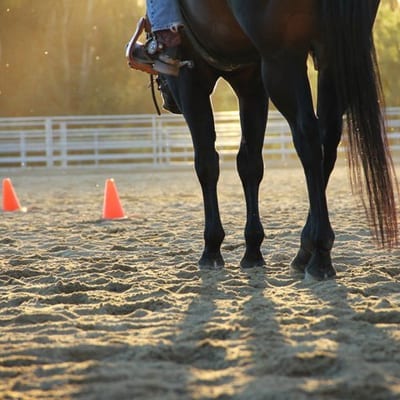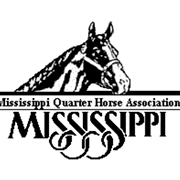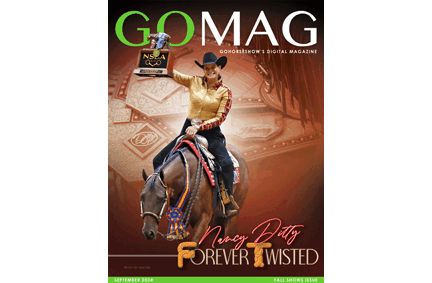Recently, AQHA and APHA have been instructing the judges to call for lengthening of stride in the western pleasure classes to improve the overall look and perception of the class. However, GoHorseShow asked several judges whether there needs to be additional emphasis placed on the pattern classes–specifically the horsemanship and equitation. Judges have been asked to space the cones out to make sure exhibitors have enough room to exhibit their horses in an appropriate manner during the pattern. However, many judges have expressed their concern that competitors are still performing the patterns too slow.
The AQHA rulebook states in Rule SHW 436 Performance (p 147), “Exhibitors that perform the pattern sluggishly and allow their horse to move without adequate impulsion, collection, or cadence will be penalized.”
GoHorseShow talked to AQHA’s Executive Director of Judges, Alex Ross about the lack of forward motion still seen in the pattern classes. “I feel very strongly about this issue, and I talk about it with the judges at every AQHA World Show,” Ross told GoHorseShow. “It seems to rear its ugly head more in the horsemanship than the equitation, but my comments are relevant for both classes. The riders need to show true gaits at the walk, trot, and lope. A good rider should be able to feel when a horse is not engaged and use the necessary aids to move them up and failure to do so will result in them being penalized. The lack of adequate cadence and self carriage by the horse and rider will result in the receiving a lower score regardless of how they perform their maneuvers. In order to score in the 80’s and 90’s, a rider must keep their horse engaged at all three gaits.”
GoHorseShow followed up and asked several judges their thoughts about this topic and what they have seen recently in the show pen—Let’s find out what they had to say!
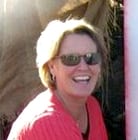 Holly Hover–You have just pushed one of my very big buttons! I am not going to be politically correct here–the pattern classes are not a venue for “Who can show a world class pleasure horse.” They are a preliminary tool to prepare riders to show and execute a winning performance in pattern events–NRHA, NRCHA, Western Riding and Trail…the individual performance events. This past December, I took great offense to the NSBA seminar and the judges’ critique of the movement of the horses. First and foremost…patterns should be executed correctly with no penalties. I don’t care if you are riding a reiner that is an incredible mover but if you miss your marker, you are out of the money! A plus 1 1/2 lead changer can never overcome a three point late lead change penalty. I will never accept the western pleasure rules of movement leaking into our discipline. Judges should design their patterns with this in mind!
Holly Hover–You have just pushed one of my very big buttons! I am not going to be politically correct here–the pattern classes are not a venue for “Who can show a world class pleasure horse.” They are a preliminary tool to prepare riders to show and execute a winning performance in pattern events–NRHA, NRCHA, Western Riding and Trail…the individual performance events. This past December, I took great offense to the NSBA seminar and the judges’ critique of the movement of the horses. First and foremost…patterns should be executed correctly with no penalties. I don’t care if you are riding a reiner that is an incredible mover but if you miss your marker, you are out of the money! A plus 1 1/2 lead changer can never overcome a three point late lead change penalty. I will never accept the western pleasure rules of movement leaking into our discipline. Judges should design their patterns with this in mind!
 Jennifer Lynn Thompson–Last weekend, I judged a show in California that had some excellent riders. What I saw, made me realize that there is still work to be done regarding the judge’s responsibility to get across what we are looking for in an excellent pattern. I watched the first horsemanship class, and by the end of watching 15 horses do their pattern at a “snail’s pace,” I couldn’t take just sitting there and not voicing my opinion to educate the riders. I made a very generalized comment that this event is not made to show how slow your pleasure horse can go. It is meant to show how well you can execute a pattern with accuracy and correctness. We no longer should show our pleasure horses at that pace, nor does it work well for the western riding or trail. Please know that there is no way you can plus a maneuver at that pace. To us judges, it shows lack of courage, incorrectness, inefficiency, and it’s very time consuming when it’s not supposed to be. When I judge a pattern class, I want to see someone who is aggressive and knows exactly where they want to go and how. Not someone who is afraid to step out and do the maneuvers and show off their skills. When you ride a pleasure horse, western riding, trail, or a pattern class, please let us judge and place you where you deserve to be. Don’t let a lesser rider beat you because of a simple rule of going too slow. Read your rules! If you are too slow, it can be cause for disqualification. It’s just so simple to step it up a notch. In one sentence, “BE BRAVE!”
Jennifer Lynn Thompson–Last weekend, I judged a show in California that had some excellent riders. What I saw, made me realize that there is still work to be done regarding the judge’s responsibility to get across what we are looking for in an excellent pattern. I watched the first horsemanship class, and by the end of watching 15 horses do their pattern at a “snail’s pace,” I couldn’t take just sitting there and not voicing my opinion to educate the riders. I made a very generalized comment that this event is not made to show how slow your pleasure horse can go. It is meant to show how well you can execute a pattern with accuracy and correctness. We no longer should show our pleasure horses at that pace, nor does it work well for the western riding or trail. Please know that there is no way you can plus a maneuver at that pace. To us judges, it shows lack of courage, incorrectness, inefficiency, and it’s very time consuming when it’s not supposed to be. When I judge a pattern class, I want to see someone who is aggressive and knows exactly where they want to go and how. Not someone who is afraid to step out and do the maneuvers and show off their skills. When you ride a pleasure horse, western riding, trail, or a pattern class, please let us judge and place you where you deserve to be. Don’t let a lesser rider beat you because of a simple rule of going too slow. Read your rules! If you are too slow, it can be cause for disqualification. It’s just so simple to step it up a notch. In one sentence, “BE BRAVE!”
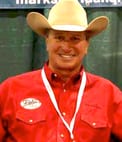 Mark Sheridan–For years I have been asking for the increased forward movement at the lope in the pleasure classes and the response from the spectators has been overwhelming in support. There have been times when I asked for the exhibitors to make a moderate increase at the lope and the spectators clapped so loud in support of this that I had to have the announcer ask that spectators hold their applause until after the class was over. My thoughts in the horsemanship and equitation classes are that, for the most part, exhibitors are not showing their horses with enough forward motion. In the novice and younger age groups, I feel that they are in the learning stages and should be judged accordingly. However, in the 14-18 and amateur classes, where the riders are very talented and advanced, I have been noting on my pattern sheets when I post them, that “correct execution of gaits will be rewarded.” I understand where this all started as well as the fact that it is easier to sit the four beat or trope with less movement in the saddle, however, a true six-foot stride, as required in the trail and western riding to achieve lead changes and various maneuvers, would be a nice pace for the horsemanship and equitation as well.
Mark Sheridan–For years I have been asking for the increased forward movement at the lope in the pleasure classes and the response from the spectators has been overwhelming in support. There have been times when I asked for the exhibitors to make a moderate increase at the lope and the spectators clapped so loud in support of this that I had to have the announcer ask that spectators hold their applause until after the class was over. My thoughts in the horsemanship and equitation classes are that, for the most part, exhibitors are not showing their horses with enough forward motion. In the novice and younger age groups, I feel that they are in the learning stages and should be judged accordingly. However, in the 14-18 and amateur classes, where the riders are very talented and advanced, I have been noting on my pattern sheets when I post them, that “correct execution of gaits will be rewarded.” I understand where this all started as well as the fact that it is easier to sit the four beat or trope with less movement in the saddle, however, a true six-foot stride, as required in the trail and western riding to achieve lead changes and various maneuvers, would be a nice pace for the horsemanship and equitation as well.
 Charlene Carter–I have been having my clients for sometime to now ride the patterns with some energy! I feel like it is a sure lack of feel when they don’t keep their horses engaged. It does reflect on their total score. I agree that this needs to be addressed, as well. Most judges that I have judged with do not want to sit and watch any pattern when the horse is being ridden in slow motion and when you can’t be sure what gait they are even exhibiting. If you want to be a winner, challenge yourself and your horse to lay those patterns out with some crisp maneuvers, make us want to stand up and cheer.
Charlene Carter–I have been having my clients for sometime to now ride the patterns with some energy! I feel like it is a sure lack of feel when they don’t keep their horses engaged. It does reflect on their total score. I agree that this needs to be addressed, as well. Most judges that I have judged with do not want to sit and watch any pattern when the horse is being ridden in slow motion and when you can’t be sure what gait they are even exhibiting. If you want to be a winner, challenge yourself and your horse to lay those patterns out with some crisp maneuvers, make us want to stand up and cheer.
 Judd Paul–The exhibitors do not get extra points for how slow they can go–this is not a western pleasure class. I tell my clients that they better be more aggressive and exhibit the gates as they are asked in the pattern classes because that is what the judges are looking for. If the best rider is really slow in their pattern, then, I will place a slightly less talented rider above them if they are doing the pattern correctly with more forward motion. In my recent judging experience, I have not seen the lack of forward motion in most of the pattern classes I have judged, but when I do see it, I penalize them accordingly.
Judd Paul–The exhibitors do not get extra points for how slow they can go–this is not a western pleasure class. I tell my clients that they better be more aggressive and exhibit the gates as they are asked in the pattern classes because that is what the judges are looking for. If the best rider is really slow in their pattern, then, I will place a slightly less talented rider above them if they are doing the pattern correctly with more forward motion. In my recent judging experience, I have not seen the lack of forward motion in most of the pattern classes I have judged, but when I do see it, I penalize them accordingly.
 Stephanie Lynn–I believe from my recent experiences judging and the way I see people preparing their horses to show that the exhibitors overall are lacking forward motion in their patterns. I think that is why we have seen so many patterns asking for “speed”, ” large fast”, and “extended” gaits. However, riders sometimes seem to only ride up a notch then double down on the slow. They do not read into the pattern that the judge wants to see forward movement. I think riders and trainers have instilled a fear of natural equine reaction, response, head carriage and movement. This has not made our riders better instead they have less ability to read and respond to their horses. It would do equitation riders well to go take a lesson on a hunter. At the same time, horsemanship riders would benefit from riding a reiner, cutter or cow horse. Horse show riders appear to have lost some of the desire to really learn to become masters at horsemanship where they can read, respond and communicate with the horse in order to teach and achieve great things.
Stephanie Lynn–I believe from my recent experiences judging and the way I see people preparing their horses to show that the exhibitors overall are lacking forward motion in their patterns. I think that is why we have seen so many patterns asking for “speed”, ” large fast”, and “extended” gaits. However, riders sometimes seem to only ride up a notch then double down on the slow. They do not read into the pattern that the judge wants to see forward movement. I think riders and trainers have instilled a fear of natural equine reaction, response, head carriage and movement. This has not made our riders better instead they have less ability to read and respond to their horses. It would do equitation riders well to go take a lesson on a hunter. At the same time, horsemanship riders would benefit from riding a reiner, cutter or cow horse. Horse show riders appear to have lost some of the desire to really learn to become masters at horsemanship where they can read, respond and communicate with the horse in order to teach and achieve great things.
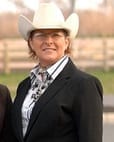 Kathryn Kope–1) Judges need to make sure that we choose patterns that allow our exhibitors to show their horses in a forward manner. Patterns that include several maneuvers grouped tightly together may inhibit the movement that we want to see. 2) Any pattern set incorrectly or too tightly will also inhibit forward movement. If you are asking for an extended gait in a horsemanship pattern, make sure you have allowed adequate space for that horse to be shown correctly. Judges have the opportunity to see the riders on the rail after the patterns are performed. By using our gait calls, we can ask our riders to move forward by lengthening strides. As judges are being encouraged to take control of the gaits in western pleasure, these same tools can easily be used if you need to see more forward motion in horsemanship and equitation. We can easily improve these classes using the tools that are already available to us. Horsemanship and Equitation patterns that ultimately score the highest will be precise, correct, and well executed by both horse and rider. I think it is a mistake to get so focused in on any one part of a pattern, gait, frame, top line or any other single aspect of a go that that one thing influences your judgement across the board, unless the fault is consistent and severe.
Kathryn Kope–1) Judges need to make sure that we choose patterns that allow our exhibitors to show their horses in a forward manner. Patterns that include several maneuvers grouped tightly together may inhibit the movement that we want to see. 2) Any pattern set incorrectly or too tightly will also inhibit forward movement. If you are asking for an extended gait in a horsemanship pattern, make sure you have allowed adequate space for that horse to be shown correctly. Judges have the opportunity to see the riders on the rail after the patterns are performed. By using our gait calls, we can ask our riders to move forward by lengthening strides. As judges are being encouraged to take control of the gaits in western pleasure, these same tools can easily be used if you need to see more forward motion in horsemanship and equitation. We can easily improve these classes using the tools that are already available to us. Horsemanship and Equitation patterns that ultimately score the highest will be precise, correct, and well executed by both horse and rider. I think it is a mistake to get so focused in on any one part of a pattern, gait, frame, top line or any other single aspect of a go that that one thing influences your judgement across the board, unless the fault is consistent and severe.
 David Denniston–I have seen a trend developing of some exhibitors showing their horses too slow and too conservatively in the pattern classes. I definitely give more credit to a hunt seat equitation or horsemanship rider that shows confidence in their horse and aren’t afraid to move him/her forward through a pattern. To me, that shows excellent rider ability and a higher degree of difficulty compared to a rider that is showing their horse too conservatively through a pattern. So, I would say I don’t necessarily “penalize” an exhibitor for being conservative, but I certainly reward one who is confident in his or her ability and their horse to move forward in a pattern.
David Denniston–I have seen a trend developing of some exhibitors showing their horses too slow and too conservatively in the pattern classes. I definitely give more credit to a hunt seat equitation or horsemanship rider that shows confidence in their horse and aren’t afraid to move him/her forward through a pattern. To me, that shows excellent rider ability and a higher degree of difficulty compared to a rider that is showing their horse too conservatively through a pattern. So, I would say I don’t necessarily “penalize” an exhibitor for being conservative, but I certainly reward one who is confident in his or her ability and their horse to move forward in a pattern.
 Kelly Boles Chapman–I believe that our equitation and horsemanship patterns not only need to be executed with more forward motion, but properly in frame and not behind the vertical as we frequently see. I don’t like drape in the reins in either of these pattern classes, and they cannot be presented in the extreme behind the vertical either. A rider that is displaying a proper degree of forward motion is performing the class requirement and exhibiting a higher degree of difficulty. While as you know, there are many factors for consideration when placing these classes, for me, of those that are in similar skill categories (ie, the above average riders in a class grouping), those that present their horse with more impulsion and forward motion should place over those riders not doing so.
Kelly Boles Chapman–I believe that our equitation and horsemanship patterns not only need to be executed with more forward motion, but properly in frame and not behind the vertical as we frequently see. I don’t like drape in the reins in either of these pattern classes, and they cannot be presented in the extreme behind the vertical either. A rider that is displaying a proper degree of forward motion is performing the class requirement and exhibiting a higher degree of difficulty. While as you know, there are many factors for consideration when placing these classes, for me, of those that are in similar skill categories (ie, the above average riders in a class grouping), those that present their horse with more impulsion and forward motion should place over those riders not doing so.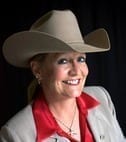 Christa Baldwin–I teach my students to go forward in the patterns. I believe it is a higher degree of difficulty and looks like you want to win and that you have more communication with your horse if you can ‘lay out’ a pattern. However, that said, your experience and the horses level helps determine how forward you can attempt that pattern. If you are a novice or with a green horse I would tell them only to do the pattern to your level and take it slow while you are bringing your horse along and increasing his knowledge or yours of doing patterns because nothing ruins a pattern horse faster than trying to rush pattern work before you or the horse is ready to step up a level. I would much rather see a smooth slower pattern than one that is hurried (before they are ready to go forward) and full of mistakes.
Christa Baldwin–I teach my students to go forward in the patterns. I believe it is a higher degree of difficulty and looks like you want to win and that you have more communication with your horse if you can ‘lay out’ a pattern. However, that said, your experience and the horses level helps determine how forward you can attempt that pattern. If you are a novice or with a green horse I would tell them only to do the pattern to your level and take it slow while you are bringing your horse along and increasing his knowledge or yours of doing patterns because nothing ruins a pattern horse faster than trying to rush pattern work before you or the horse is ready to step up a level. I would much rather see a smooth slower pattern than one that is hurried (before they are ready to go forward) and full of mistakes.
Let us know what you think! Do you think the exhibitors are showing their horses too slow in their patterns, and if so, do you think the judges need to address the exhibitors more about this issue?


